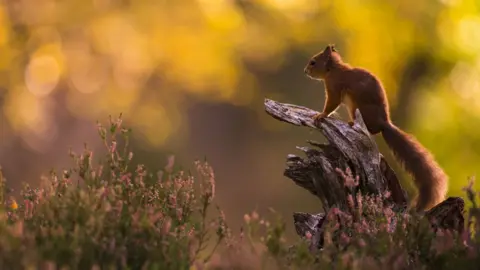Scotland's ancient Caledonian pinewoods could vanish - study
 Getty Images
Getty ImagesScotland's ancient pinewoods are in danger of disappearing forever, a conservation charity has warned.
Fragments of the once vast Caledonian forest are dotted across parts of Argyll, Highlands and Aberdeenshire.
It is home to descendants of trees that appeared at the end of the last ice age in Scotland about 11,000 years ago.
However research by charity Trees for Life suggested the spread of non-native trees and grazing by deer has threatened the woods' survival.
It said rising temperatures due to climate change also pose a risk.
The Scottish government said it was investing heavily in projects to protect "irreplaceable" Caledonian pinewoods.
Trees for Life said its four-year analysis was the first major study into the health of the pinewoods in more than 60 years.
It estimates that about a total of 42,000 acres (16,998ha) of original woodland survives.
Trees for Life has called for urgent action to tackle high deer numbers, non-native conifers and also improvements in management of the pinewoods.
 Trees for Life
Trees for LifeChief executive Steve Micklewright said: "Our findings are an alarm bell for Scotland's Caledonian pinewoods, which are such an important part of the country's culture and environment.
"The majority of the surviving fragments are now on a knife-edge, and bold action is needed to save them from being lost forever."
He added: "A landscape-scale approach backed by the Scottish government is urgently needed to save, expand and connect up these precious woodlands before it is too late."
More than 80 fragments of Caledonian forest can be found across Scotland from near Loch Lomond in the south to near Ullapool in the north.
Areas of pinewood still survive around Torridon in the west and eastwards towards Aberdeen. Some of the largest areas are in the Cairngorms.
They provide habitat for red squirrels and birds such as capercaillie, crested tits and crossbills.
The pinewoods' tree species include Scots pine - Scotland's national tree - as well as birch and juniper.
Trees for Life said deer were a problem because they eat saplings, while non-native conifers such as sitka spruce could "crowd out" native trees.
The charity said the ancient woodlands were recovering in some locations thanks to conservation work, including Glen Affric and around Glenfeshie, which are both in the Highlands, and Mar Lodge near Braemar in Aberdeenshire.
Senior ecologist James Rainey, who led the study, said: "These pinewoods should be playing a key role in Scotland's fight-back against the climate and nature emergencies, but right now most are on their last legs.
"It's not too late to turn this around, but that means seriously stepping-up restoration and rewilding action."
The Scottish government said efforts to enhance the pinewoods included public agency Scottish Forestry supporting landowners and managers through the Forestry Grants Scheme, which has been backed by £69.5m funding this year.
A spokeswoman said: "Scotland's Caledonian pinewoods are irreplaceable and a vital habitat which is treasured by many.
"That's why we are investing heavily, including in many of the interventions identified in this research, which the Scottish government and its agencies have been engaged with."
The Caledonian Forest covered huge swathes of Scotland, and even reached the Western Isles and Shetland 5,000 years ago.
A change to a cooler and wetter climate, along with human activity, led to a decline in the forest's coverage.
By the 1900s about 5% of Scotland's land area had woodland, according to Scottish government agency NatureScot.
